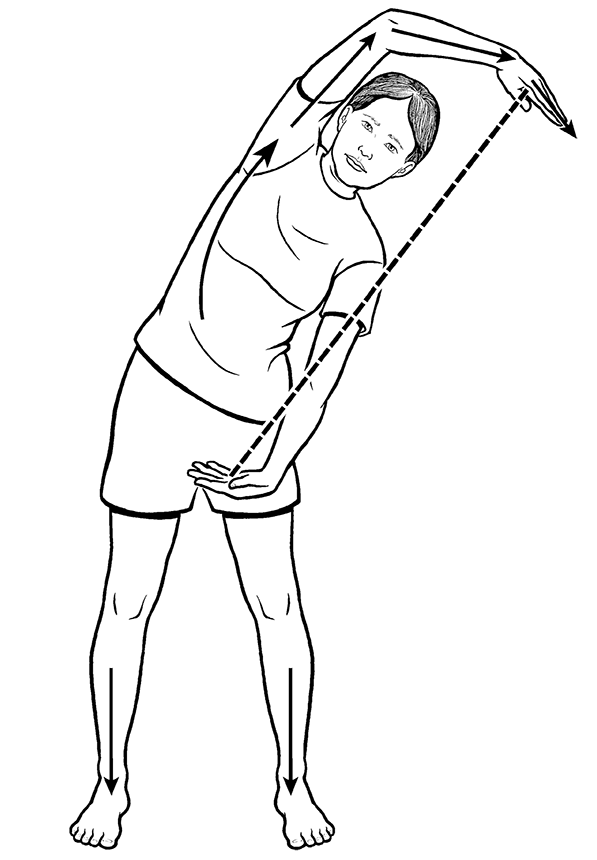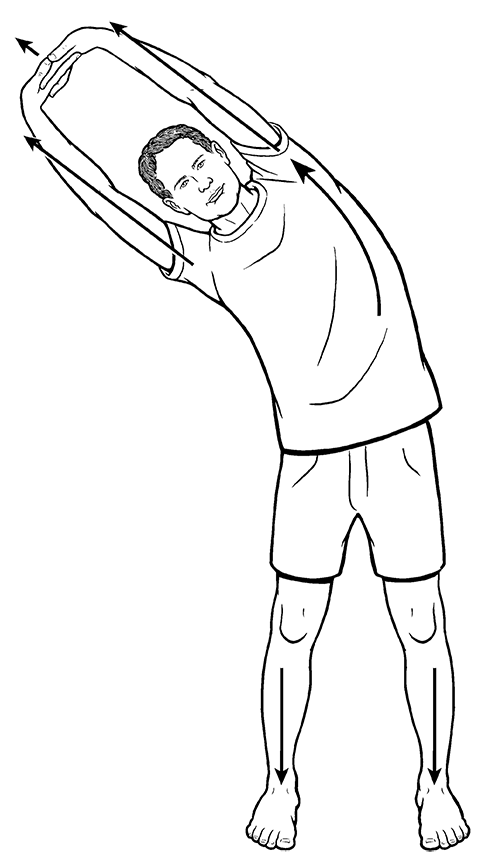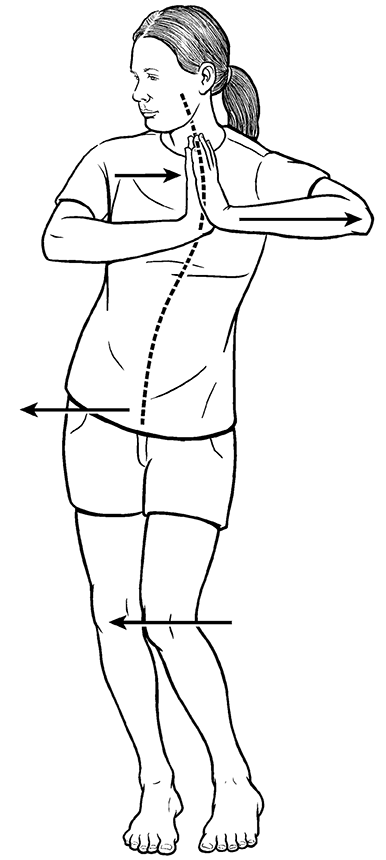Chinese Healing Exercises (19 page)
Read Chinese Healing Exercises Online
Authors: Steven Cardoza
Tags: #Taiji, #Qi Gong, #Daoist yoga, #Chinese Healing, #Health, #medicine, #remedy, #energy

Techniques used
Stretching, joint mobilization, visualization, focused breathing.
Method
Stand with your feet parallel, slightly wider than shoulder-width apart. Raise your arms out to your sides, imaginging that you are holding a large Yin-Yang mandala between your hands, somewhat like a very large ball. Try to feel the connection between your hands, even at that distance apart
(
Fig 6.6A
).
With the sense that you are rolling your hands around the surface of the large ball, raise your right arm straight up over your head so that your palm is more or less facing the center of the top of your head, with your fingertips pointing left. Try to keep your shoulder lowered so that it does not approach your right ear. Your elbow should point toward the right, creating just a slight bowing of your arm. Simultaneously place your left hand in front of you, palm facing up on the midline of your body, at about the height of your pubic bone. The tip of your left elbow should point toward the ground in front of the left side of your body.
 Figure 6.6A (Yin-Yang Side Bend)
Figure 6.6A (Yin-Yang Side Bend)
 Figure 6.6B (Yin-Yang Side Bend)
Figure 6.6B (Yin-Yang Side Bend)
Without bending or leaning forward or backward, bend to the left primarily from the left side of your waist, rotating the mandala counterclockwise to the left as you do so. Your left hand will move toward (or possibly past) the front of your right hip, while your left hand moves well beyond the left side of your head
(
Fig 6.6B
).
Because you are holding the large taiji ball, your hands and arms will not collapse or come any closer together than they were in your starting position. If you allow them to come any closer together, you will minimize the stretch and minimize the benefit. Feel your arms extending, out of your armpits and all the way beyond your fingertips. Doing that, you will feel the stretch more strongly along the left side of your body. You may feel or hear popping and cracking in your back as the vertebrae open on their sides. That's nothing to be alarmed by, and in fact will make your back feel more comfortable and open, like a chiropractic adjustment. The right side of your body may feel compressed, especially between the side of your pelvis and your lower ribs. That's okay too, and helps to massage your spleen, intestines, and pancreas. You do want to try create some sense of openness there nevertheless, so it doesn't become uncomfortably compressed. Better yet is to feel a springiness, so the compressed side feels like it wants to bounce back open.
Rotate the taiji ball clockwise, to the left, as you return to an upright position. Although you don't stop in the upright position, as you pass through it your arms will be spread to your sides. Continue your bend to the left this time, again from your waist and still making sure you do not lean forward or backward, keeping your arms moving in a clockwise circle. At the end point, your right hand will be more or less palm down and facing your left hand, which is more or less palm up just past your right hip. Still feel for the connection between your palms as though you are holding the large ball. Arms should feel extended out from the armpits all the way beyond the tips of the fingers. Then return to an upright position, and repeat to the right. Do ten to twelve repetitions.
Breathing can be done in one of two ways. If the stretch is very easy for you, inhale as you bend to the side. That will make your lungs and belly expand more, which will increase the stretch both internally and externally. Exhale as you return to an upright position. If the stretch is difficult for you, exhale as you bend to the side. Exhalations always help muscles to relax and release and thus will make the stretch easier for you. Also, less expansion of your lungs and belly will decrease the internal pressurization, again making it easier for you.
Variation
This familiar variation is taken from the Baduanjin Eight Golden Brocades qigong set. The purpose, benefits, and methods are very similar with these exceptions.
Interlock the fingers of both hands together, palms up in front of your low belly. Keep your fingers interlocked throughout. Raise your arms above your head, and turn your hands so the palms are facing the sky. Exert a gentle pressure upward, as though you were trying to push something, but avoid locking your elbows, keep a slight bend in them
(
Fig 6.7A
).
This increases the stretch through your arms and into your palms. Bend side to side and breathe as instructed above, maintaining the sense of pushing with your interlocked fingers
(
Fig 6.7B
).
By having the back of your wrists more closed and the front of your wrists more open, this variation stretches the Yin surfaces of the arms more, increasing qi flow through the Arm Yin meridians of the Heart, Pericardium, and Lungs while decreasing it through the Yang meridians of the Large and Small Intestines and the Sanjiao. You might chose this variation if you know you want to target your heart and lungs more, or want to open the yin surfaces of your arms more. The muscles there tend to constrict with overuse, so the additional stretch may feel better to you. The benefits throughout the legs, torso, and spine are otherwise identical to the primary version.


Figure 6.7A and 6.7B (Yin-Yang Side Bend)
5. Lateral Swimming Dragon
Like the Eight Golden Brocades, the Swimming Dragon is another simple, popular qigong practice; it has one main and two secondary movements. Here, we'll use a secondary movement to continue opening the back and spine while adding benefit to the pelvis and hips.
Purpose
Physical:
Stretches the muscles between the sides of the upper pelvis and lowest ribs; stretches the neck muscles while rotating the cervical spine; laterally flexes and extends the entire vertebral column in an S curve, stretching the related small internal muscles, tendons, and ligaments. This can help minimize the discomfort of scoliosis. This is one of the few exercises that stretches the hips. Massages most of the internal organs.
Energetic:
Benefits the Gall Bladder and Spleen meridians, and frees the Du and Urinary Bladder meridians. Laterally unbinds the Shoulder's Nests and Kwa, gently pumping qi flow through those energetic structures and furthering the connection through the core side channels between the legs and torso, and arms and torso.
Techniques used
Stretching, joint mobilization, focused breathing.
Method
To establish your starting position, stand with your feet very close together. Ideally, they should be touching along their entire length, but if your balance makes that too difficult, spread your feet apart only wide enough so that you feel secure and stable. Keep them parallel. Place your palms together in front of your chest, fingers pointing toward the sky, thumb side toward your chest and little finger side directed outward in front of you, in a “prayer hands” position. Push your palms together with a gentle pressure, and keep your elbows pointing straight out to your sides, doing your best to keep them pointing that way throughout this exercise.
Next, without moving your feet, simultaneously move your hips to the right, while pushing your elbows to the left, and turn your head to the right so that your chin moves close to or over your right shoulder. This creates a lateral S-shaped curve in your spine from the tip of your tailbone to the base of your skull
(
Fig 6.8
on next page
).
In this movement, some deviation is inevitable, but you nevertheless want to strive to keep your arms parallel to the ground, both elbows pointing to the sides exactly perpendicular to your body, and to keep every part of your torso facing straight forward, including your hips and knees. It's very common to rotate your body so that your right hip moves rearward and your left hip forward. While doing so is not dangerous, it does minimize the lateral stretch in your spine and hips, thereby minimizing the overall benefits.
Return to your starting position, and repeat in the opposite direction, moving your hips to the left, elbows to the right, and turning your head to the left. Again return to starting position.
Inhale as you turn to the side, and exhale as you return to your starting position. Pace your movement to match a comfortable breathing rate. Repeat at least ten times, but it's fine to do more if you'd like.
 Figure 6.8 (Lateral Swimming Dragon)
Figure 6.8 (Lateral Swimming Dragon)
6. Standing To e Touch, Legs Together
This is a common exercise with some variation used in many traditions, including standard Western gymnastics. This version is done more slowly than may be seen in a gym class, using breath to facilitate the release and stretch. It will further open the back and spine, and has associated energetics involved.
How far you bend forward may be limited by a restriction in your back, but equally common the restriction may be in your hamstrings. It may be helpful to do the hamstring stretches in the Seated Leg exercises section before attempting this one, especially if you have a known back problem, to minimize any possible strain. In this standing version, gravity will be pushing down more on your back than in the seated hamstring stretch.